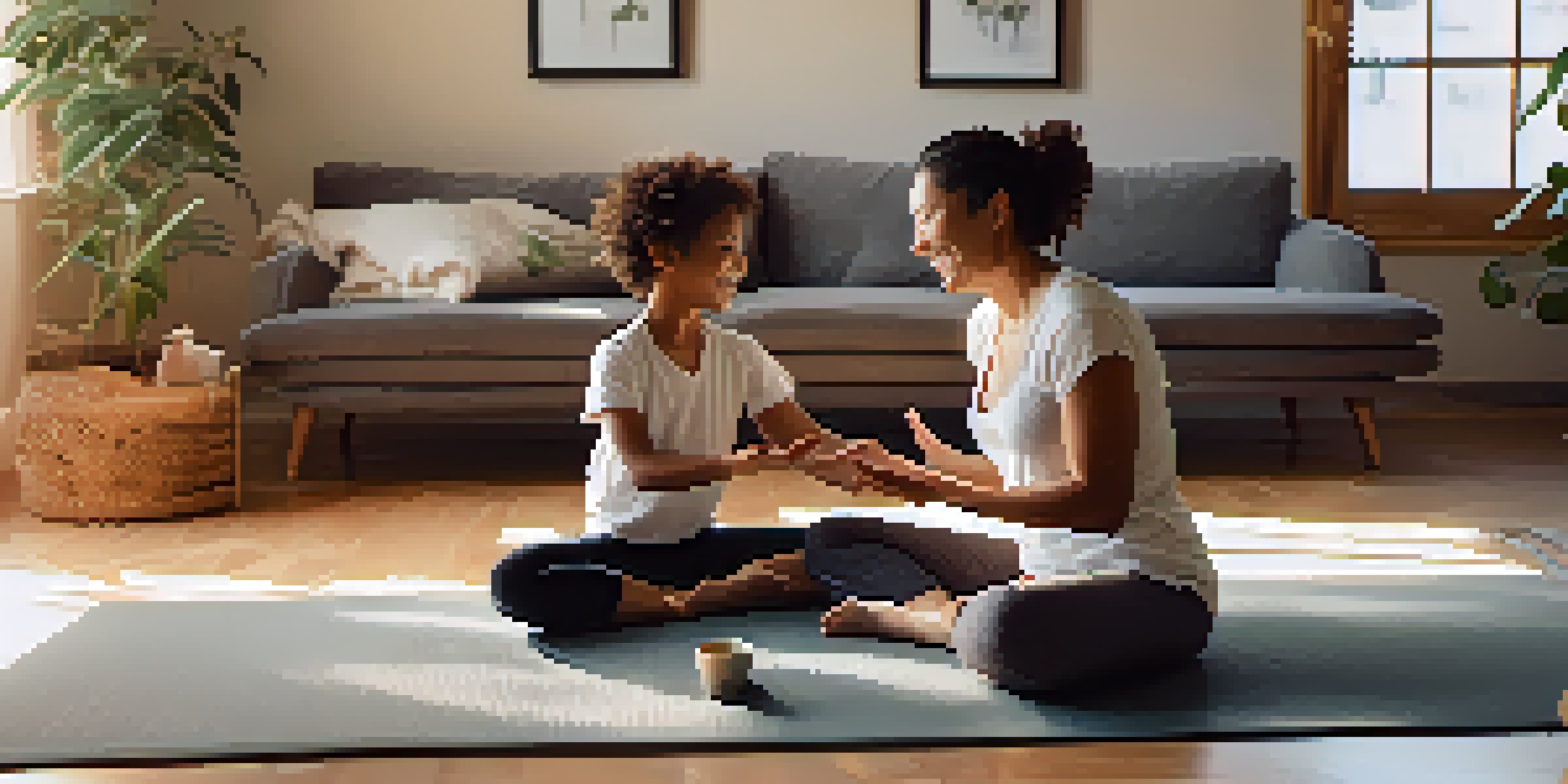Connecting with Kids: Yoga Activities for Parent-Child Bonding

The Benefits of Yoga for Parent-Child Relationships
Yoga offers a unique way for parents and children to connect. Through shared activities, both can develop trust and understanding. This shared experience not only enhances physical health but also promotes emotional bonding.
Yoga is the journey of the self, through the self, to the self.
When practicing yoga together, parents can model healthy behaviors, encouraging kids to be mindful and present. Children learn to express their feelings and manage stress in a positive environment. This creates a foundation for open communication and deeper connections.
Moreover, the calming effects of yoga can help reduce anxiety for both parents and children. As you breathe and move together, you create a peaceful space that fosters connection. This can be especially beneficial in today’s fast-paced world.
Starting with Simple Breathing Exercises
Before diving into more complex poses, start with simple breathing exercises. These can help ground both you and your child, making it easier to focus. A favorite technique is the 'bubble breathing' where you imagine inhaling the scent of a bubble and then exhaling slowly as if blowing it away.

Practicing together can be a fun way to introduce mindfulness. Encourage your child to close their eyes and visualize their favorite place while breathing deeply. This not only calms the mind but also strengthens the bond through shared imagination.
Yoga Connects Parents and Kids
Practicing yoga together fosters trust, understanding, and emotional bonds between parents and children.
As you both become more comfortable, you can incorporate playful elements like counting breaths together. This creates a fun rhythm and reinforces the idea that yoga is enjoyable and not just a chore.
Incorporating Animal Poses for Fun
Animal poses are a fantastic way to engage kids in yoga. Children can relate to these poses easily, making them fun and interactive. For example, the 'downward dog' can be transformed into a playful bark, while 'cat-cow' can inspire giggles with sound effects.
In yoga, we learn to become aware of our thoughts, feelings, and experiences, and to accept them without judgment.
Creating a story around the poses can also enhance the experience. For instance, you can pretend to be in a jungle, with each pose representing a different animal. This imaginative play not only builds physical skills but also deepens emotional ties.
Moreover, practicing these poses together can lead to moments of laughter and joy. Sharing these light-hearted experiences fosters a sense of togetherness, reinforcing the bond you share.
Exploring Partner Yoga for Connection
Partner yoga is a delightful way to strengthen your bond with your child. By practicing poses that require teamwork, you both learn to rely on each other. Examples include seated forward bends where you can support one another’s backs.
This collaborative approach encourages communication and trust. As you navigate poses together, you’ll find yourselves laughing and cheering each other on. Such moments can lead to deeper conversations about teamwork and support.
Fun Through Animal Poses
Incorporating animal poses makes yoga engaging for kids, promoting laughter and imaginative play.
Additionally, partner yoga can be a great way to teach your child about balance—both physically and emotionally. It’s a reminder that you’re always there to catch them when they fall, reinforcing the importance of support in your relationship.
Creating a Relaxing Yoga Routine
Establishing a calming yoga routine can become a cherished family ritual. Choose a time when both of you can unwind, perhaps before bedtime or on weekend mornings. Consistency helps create a sense of security and belonging.
Incorporate gentle stretches and relaxation techniques into your routine. Transitioning from activity to calmness can help both of you unwind from the day. Ending with a few moments of quiet meditation can enhance the overall experience.
Encouraging your child to express how they feel after each session can foster communication. This allows for reflection on what they enjoyed or found challenging, creating an opportunity for deeper discussions and understanding.
Using Yoga to Navigate Emotions
Yoga can serve as a powerful tool for navigating emotions. Teach your child to recognize feelings like anger or frustration and channel them through movement. For example, a 'warrior pose' can embody strength and resilience.
Encourage your child to express their emotions verbally before or after practicing poses. This creates a safe space for them to share their thoughts and feelings. You can share your own experiences as well, reinforcing that it’s okay to feel a range of emotions.
Celebrating Yoga Progress Together
Recognizing milestones in your yoga journey boosts confidence and strengthens the parent-child relationship.
By connecting movements with emotions, you’re helping your child develop emotional intelligence. This understanding will serve them well in relationships outside of your own, creating a foundation for healthy communication.
Making Yoga a Family Activity Beyond the Mat
Incorporating yoga into family activities can extend beyond the mat. Encourage mindfulness during everyday tasks, like eating or walking. Simple practices like taking deep breaths before meals can promote awareness and connection.
Consider family outings that integrate movement, such as hiking or dancing. These activities foster a sense of togetherness while also encouraging physical health. You can even create fun challenges, like seeing who can hold a pose the longest.

Lastly, remind your child that yoga is not just about poses—it’s about being present. The more you practice being mindful together, the stronger your bond will become. It’s a beautiful way to embrace life as a family.
Celebrating Progress Together
Celebrating your yoga journey together can reinforce the bond you've built. Acknowledge the small victories, like mastering a new pose or completing a routine. These moments of recognition can boost confidence and motivation for both you and your child.
Consider creating a yoga journal to document your experiences. You can write down favorite poses, emotions felt during practice, and goals for the future. This tangible record serves as a reminder of your journey together.
Finally, make it a point to regularly check in with each other about your experiences. Sharing thoughts about what you’ve learned or enjoyed strengthens your connection. Celebrating progress, both big and small, enriches your relationship and creates lasting memories.